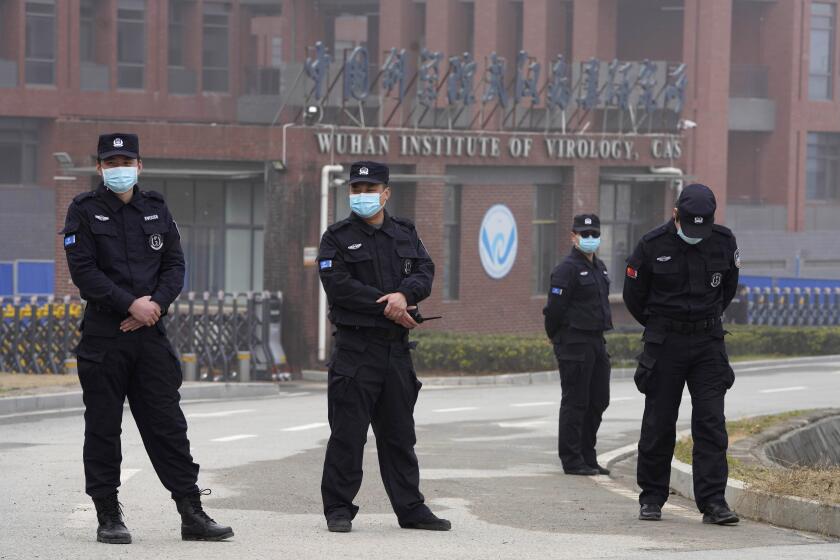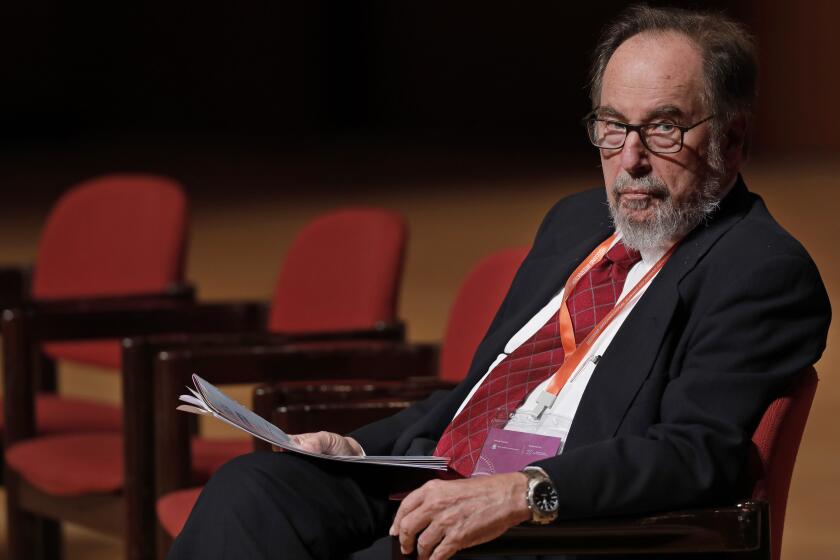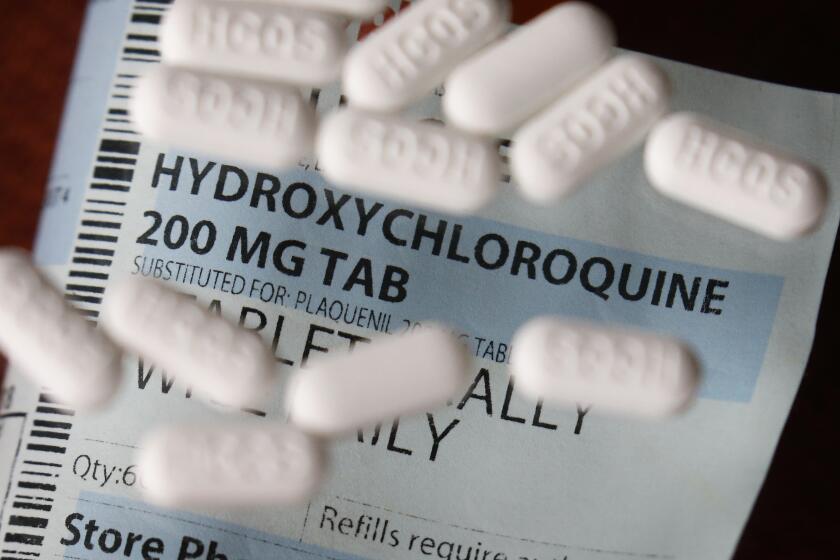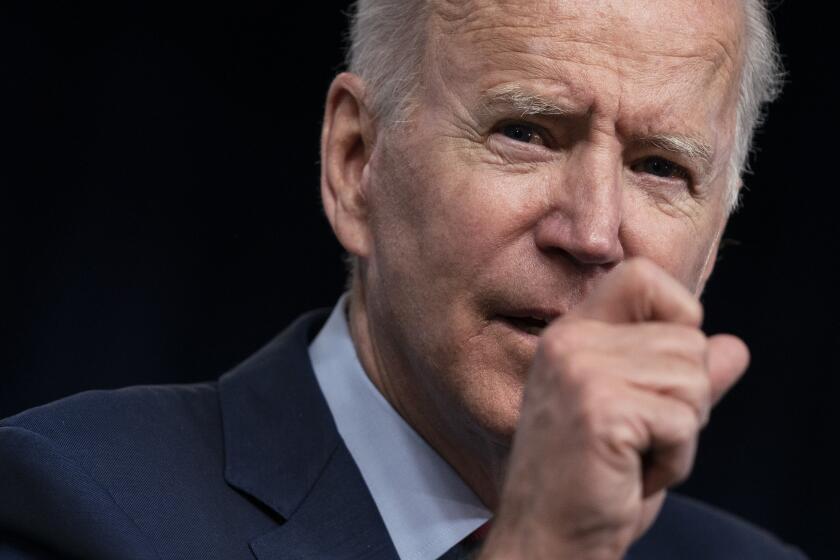The lab leak theory for the origin of COVID-19 is fading

- Share via
The theory that the virus responsible for COVID-19 escaped from a Chinese government lab has fallen off the front pages in recent months, but research into the virus’ origin has continued — and it’s making the lab-leak theory look more unlikely.
Recent scientific papers give more credence to “zoonotic” origin of the virus — that is that it spread to humans from animal hosts, not through artificial means.
That’s the basis of a paper by researchers in China and at the University of Glasgow published in Science on Aug. 21, exploring “the animal origin of SARS-CoV-2,” the virus causing the pandemic.
There’s substantially more evidence on the side of a natural origin compared to a lab leak.
— Virologist Angela Rasmussen
“There is currently no evidence that SARS-CoV-2 has a laboratory origin,” bluntly concludes a separate paper coauthored by 21 virologists from the U.S., Canada, Britain, China, Australia and Austria and scheduled for publication in the Sept. 16 issue of the peer-reviewed journal Cell.
That paper attributes the suspicion that the virus might have originated in a lab to “the coincidence that it was first detected in a city that houses a major virological laboratory,” the Wuhan Institute of Virology.
Get the latest from Michael Hiltzik
Commentary on economics and more from a Pulitzer Prize winner.
You may occasionally receive promotional content from the Los Angeles Times.
But the authors observe that “Wuhan is the largest city in central China with multiple animal markets and is a major hub for travel and commerce,” making it more likely that the virus reached humans from animal hosts, such as raccoon dogs and civets, known to be vulnerable to the infection and known to have been sold in a major Wuhan market at the time COVID-19 was first identified in humans.
The papers reached press just as an investigation by U.S. intelligence services ordered by President Biden was wrapping up. The investigation was inconclusive about the origin of the virus, according to reports in the Washington Post and Wall Street Journal.
That wouldn’t be a surprise to scientists who have been delving into the issue for more than a year.
“Nobody has evidence to confirm or falsify one hypothesis over the other,” says Angela Rasmussen of the University of Saskatchewan, a coauthor of the Cell paper. “But what I and my coauthors decided after going through all the evidence is that there’s substantially more evidence on the side of a natural origin compared to a lab leak.”
It’s true that China hasn’t been forthcoming with research records from the Wuhan Institute or other government facilities. But China is hardly the only country that keeps some biological research under wraps. The U.S. has done so, at least in the past; the U.S. government says that such research was ended many years ago.
The lab-leak hypothesis for COVID-19 is getting lots of attention, but there remains no evidence for the claim that COVID-19 originated in a laboratory in China or anywhere else.
Determining the origin of the virus is important because it will govern steps the international community can take to avert future pandemics.
If its source is traced to a laboratory, that points to the need to upgrade biological security at facilities world-wide. If it jumped from animals to humans, that points to the need for stricter regulation of so-called “wet markets” where live animals are sold for meat, and of other human interactions with animals in the wild.
Focusing on the wrong origin, by the same token, means wasting global resources on fruitless measures. And pointing an accusatory finger at Chinese laboratories may prompt China to shy away from participating in any international effort to address the risk of future pandemics.
It would be inaccurate to say that evidence for the lab leak theory is fading. That’s because there never was any evidence for the theory, just conjecture.
Virtually from the outset, the lab leak theory was driven by ideology, not science. It employed the vocabulary of science, but that’s a familiar technique for bamboozling a susceptible public.
“The only evidence for a lab leak, period, is just that the virus emerged in Wuhan, where the Wuhan Institute of Virology is,” Rasmussen told me. “That’s it. Since day one, that has been the only piece of evidence.”
The assertions supporting the lab leak theory are not only conjectures, but in many cases provably wrong conjectures. They’re often based on misinformation, scientific ignorance, or even bad translations from Chinese documents.
Proponents have made much of the fact that the Virology Institute is only about 300 yards from the animal market that appeared to be the source of the first infections, for instance.
Hiltzik: A Nobel laureate backs off from claiming a ‘smoking gun’ for the COVID-19 lab-leak theory
David Baltimore was quoted as finding a ‘smoking gun’ for the lab-leak theory of COVID-19’s origins. He wishes he hadn’t said that.
But that’s wrong. The facility 300 yards away is the Wuhan Center for Disease Control, which doesn’t conduct research on raw viruses; the Virology Institute is about 7.5 miles from the market and on the far side of the Yangtze River.
Attributing the disease outbreak to the lab would be akin to stating that a disease outbreak in Santa Monica had to have originated in a lab at UCLA about seven miles away.
The tendency to draw sinister conclusions from bad information has continued to the present day. Earlier this month, the Washington Post and Wall Street Journal both published opinion articles asserting that the Virology Institute had issued a $606-million contract to renovate its air conditioning system.
The pieces were based on a tendentious report by Rep. Michael McCaul (R-Texas) which asserted that the contract raised questions about how well the system was functioning prior to the COVID-19 outbreak.
McCaul’s math was way off, however, because his report misinterpreted the numbers in a Chinese-language document. The contract was actually for $606,000, which doesn’t sound like much for a complex of buildings up to seven stories tall. The Post and Journal eventually corrected the figures, but not the inferences of the authors — who included Robert Redfield, a director of the U.S. Centers for Disease Control and Prevention under Trump.
By contrast, meanwhile, support for a “zoonotic” origin has gained ground among scientists. Much of the evidence for this pathway is circumstantial, but that doesn’t mean it’s weak or dubious.
In June, researchers from Canada, Britain and China reported that 38 species of wild animals had been on sale in Wuhan markets for food and as pets through 2019. Many were species known to be possible carriers of the SARS2 virus.
As with chloroquine, there’s no reliable evidence that ivermectin works against COVID-19. You can’t censor what doesn’t exist.
Almost all were “sold alive, caged, stacked and in poor condition.” Butchering was done on-site, “with considerable implications for food hygiene and animal welfare,” the researchers found.
Environmental samples taken at the central Huanan wet market in Wuhan shortly after the Chinese government shut it down in response to the pandemic showed widespread contamination by the virus, “compatible with introduction of the virus through infected people, infected animals or contaminated products,” the World Health Organization reported in February.
The earliest reported COVID-19 cases were clustered around that market, not the Virology Institute miles away.
Scientists haven’t yet detected the virus in live animals thought to be likely direct or intermediate hosts before its jump to humans, including bats, raccoon dogs or palm civets, but it’s not unusual for that sort of investigation to take years.
The spread of the virus from animal host to humans closely matches that of previous disease outbreaks. “All previous human coronaviruses have zoonotic origins,” the Cell paper states, “as have the vast majority of human viruses.” The emergence of SARS2, the authors observe, “bears several signatures of these prior zoonotic events,” including its association with live animal markets.
Claims that the genetic structure of SARS2 points to a laboratory origin, often made by lab-leak proponents, don’t stand up to scientific scrutiny, the Cell authors find.
One claim is that the virus is so well adapted to human infection that it must have been tailored for the purpose. In fact, the virus in its original form was a generalist — capable of efficiently infecting multiple species, “including mink, tigers, cats, gorillas, dogs [and] ferrets.”
“We know it can jump species fairly easily,” Rasmussen says. Moreover, the appearance of multiple variants such as the Delta variant, with improving transmissibility, suggests that it was not ideally suited to human hosts at first.
“If this was so beautifully adapted to people,” Rasmussen says, “it wouldn’t be adapting to us in so many ways.”
Speculation that the virus’ features could only have been the product of artificial design are also unfounded, the researchers write.
The war against COVID-19 can be won if Americans don’t give up.
Chief among these is the so-called furin cleavage site, where an enzyme breaks the virus’ spike in two to enable it to better penetrate and therefore infect human cells. Some lab leak proponents assert that the furin cleavage site is too novel to have occurred naturally.
That’s not true, however. “Furin cleavage sites are commonplace in other coronavirus spike proteins,” the authors state, including several human viruses.
Although laboratory accidents leading to infection on the outside are not unprecedented, “no epidemic has been caused by the escape of a novel virus,” the Cell paper notes. There is no evidence that the Wuhan virology lab or any other facility in China was working on a virus sufficiently similar to SARS2 to be its precursor.
How this unproven scenario was developed at the State Department by a clutch of ideologues was exposed in June by former Assistant Secretary of State Christopher Ford, who was a first-hand witness to the process.
Ford called the lab leak hypothesis “clearly a real possibility.” While in office, however, he demanded that before it was put out in public by the State Department or by then-Secretary of State Michael R. Pompeo specifically, it be backed up with scientific rigor.
“We need to make sure what we say is solid and passes muster from real experts before we risk embarrassing and discrediting ourselves in public,” Ford emailed two of the in-house lab leak proponents in early January.
Ford recounts how some State Department officials latched onto the premise that the virus had been developed by the Chinese government as a biological weapon. That was still a feature of the theory when it first reached the public, though the assertion that the virus was deliberately developed as a weapon has since been recast as a claim that a virus being studied by researchers escaped from a Chinese government lab by accident.
Research supporting the theory that the pandemic originated in a natural jump from animals to humans has moved ahead, with more evidence accumulating drawn from the virus’ genetic footprint. Evidence for the lab leak, however, has stagnated. Nothing has been posited about the possibility of a laboratory leak this year that wasn’t posited in 2020, when the theory was widely dismissed.
No reputable scientist would assert that a laboratory origin of the SARS2 virus is impossible or inconceivable. But it’s looking more and more like a dead end. That means pursuing it, especially to the exclusion of natural explanations, may not be merely foolhardy, but dangerous for the health of humankind.
More to Read
Get the latest from Michael Hiltzik
Commentary on economics and more from a Pulitzer Prize winner.
You may occasionally receive promotional content from the Los Angeles Times.















